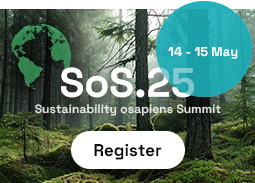Tempo di lettura 4 min.
The Corporate Sustainability Reporting Directive (CSRD) requires companies to report on various aspects of sustainability, including environmental and social factors. Currently, listed companies with at least 500 employees are required to report for the fiscal year 2024. The regulation will be phased in over the next years and will be relevant for smaller companies from January 2025.
Transparent Sustainability Reporting
There is a growing demand for transparent and reliable information on companies’ environmental, social and governance (ESG) performance. Companies subject to the CSRD must disclose specific ESG information and the measures they have already implemented in a comprehensive and detailed manner to ensure transparency. This allows various stakeholders, such as investors or customers, to gain insight into the company’s activities.
To comply with the CSRD, companies must adhere to the European Sustainability Reporting Standards (ESRS), which outline the required information and reporting methodologies. The European Financial Reporting Advisory Group (EFRAG), of which osapiens is a partner as an official “Friend of EFRAG,” has published key guidance to help companies improve their sustainability reporting. This blog post summarizes the necessary steps.
Three Steps to a Sustainability Report
To prepare a sustainability report, companies need to collect a significant amount of data, both from within the company and from stakeholders. This data is collected in three steps and then compiled into the sustainability report.
Internal data includes IROs (Impacts, Risks, Opportunities), which are data points and aspects that can have a negative or positive impact on the environment, or present risks or opportunities for improving sustainability. Examples include the company’s water usage, energy consumption, or conservation projects it supports. Identifying these IROs is time consuming and resource intensive. With osapiens’ software solution, the osapiens HUB for CSRD, companies have access to more than 300 predefined IRO templates that simplify the lengthy IRO identification process. In addition, data from suppliers and partners is needed, for example, to collect emissions data for transportation and production.
The IROs relevant to the company must then be evaluated. After the evaluation, the osapiens software solution automatically calculates a score that is used to determine the materiality of the individual IROs. Material IROs are those that exceed a threshold value and thus have a significant positive or negative impact or represent a high financial opportunity or risk. Both the company’s own business activities and those in the upstream or downstream value chain must be considered.
The two Dimensions of Double Materiality
The Double Materiality Assessment, also known als Dual Materiality, is the first step and a key concept in sustainability reporting. It considers two dimensions: financial materiality and environmental and social impact.
Impact materiality focuses on the positive and negative impacts of a company’s operations, products and services on the environment and society. For example, if a company is involved in fishing and contributes to overfishing, its activities threaten marine fish stocks. Overfishing threatens biodiversity and reduces CO2 absorption, meaning that the company’s activities have a negative impact on the environment.
Financial materiality examines how sustainability issues affect the company’s financial performance. It identifies risks and opportunities that affect the financial position, liquidity and cost of capital. For example, a decline in fish stocks, which is an external environmental condition, would negatively affect the company’s profits because it would have fewer fish to sell.
Preparing the Sustainability Report
For reporting purposes, the collected IROs are linked to the previously established strategies, measures and objectives, as well as disclosure requirements. Key Performance Indicators (KPIs) are metrics that reflect progress toward the company’s primary success and performance goals. The osapiens software provides an overview of relevant KPIs and data points, simplifying data management through automated data collection.
osapiens’ software solution automates the aspects of compliance that can be automated. This reduces manual effort for staff and the report is automatically generated in the correct format. The European Single Electronic Format (ESEF) is a standardized electronic reporting format for company accounts across the EU. Our software solution provides a secure and simplified process from validation to submission of the sustainability report in ESEF format, saving time and significantly reducing administrative burden.
About osapiens
osapiens – one platform for sustainable growth
osapiens sviluppa soluzioni software basate su cloud che consentono alle aziende di promuovere una crescita sostenibile lungo l’intera supply chain. Grazie alla potente integrazione dei dati e alle analisi in tempo reale, osapiens supporta le aziende nel consolidare, interpretare e utilizzare dati operativi complessi e metriche di sostenibilità.
osapiens HUB, una piattaforma scalabile basata sull’intelligenza artificiale, combina oltre 25 soluzioni per migliorare l’efficienza operativa e la sostenibilità in due aree fondamentali: le soluzioni di trasparenza consentono alle aziende di mappare e monitorare l’intera catena del valore per mitigare i rischi della supply chain e conformarsi ai requisiti normativi quali EUDR, CSRD e CSDDD. Le soluzioni di efficienza favoriscono l’eccellenza operativa semplificando i processi di manutenzione, ottimizzando le prestazioni degli asset e consentendo una pianificazione, programmazione e gestione degli interventi sul campo efficienti.
Con sede a Mannheim, in Germania, osapiens lavora con un team internazionale di oltre 500 dipendenti per supportare più di 1.800 clienti in tutto il mondo.
Christian Feuring
External Communications Manager


 Indietro
Indietro